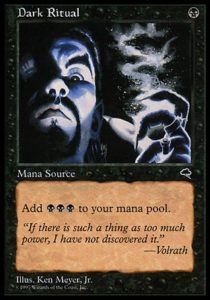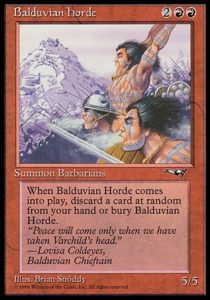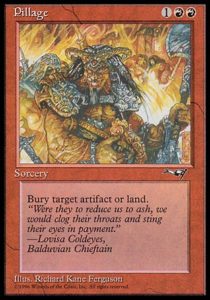As of the time of this article, only three Masters 25 commons have been spoiled. They don’t reveal any set mechanics or provide deep insight into what colors are doing, but they are all immensely powerful cards. Today, let’s briefly look at Dark Ritual, Pillage, and Balduvian Horde.
Dark Ritual is part of the Alpha boon cycle alongside Constructed all-star Lightning Bolt, Limited power trick Giant Growth, runt of the litter Healing Salve, and greatest draw spell of all time, Ancestral Recall. No, that cycle wasn’t remotely balanced and no, mana acceleration is no longer in black’s color pie. Still, Dark Ritual is one of black’s most iconic and enduring spells, accelerating out Hypnotic Specters in 1993, Necropotences in 1995, and storming off to this day.
Dark Ritual as a common suggests three things: there is a storm deck (in UB, BR, or UBR), there is a big mana deck (probably in BG), or there is a B/x midrange deck. All that we can know for certain is that Dark Ritual is going to enable some truly busted early turns, as well as make the cut in decks that have nothing to do with a late game mana accelerant. Lotus Petal is generally unplayable in Limited, but gaining +2 mana is a big jump up from +1, particularly when triple black allows you to cast normally uncastable threats like Phyrexian Obliterator. And Masters formats aren’t like normal Limited sets: successful decks are synergistic rather than based on raw power, looking more like Cube decks than normal draft decks. Dark Ritual is likely going to range from amazing to unplayable, and recognizing that is key to harnessing its dark power.
Back in ’96, Balduvian Horde looked a whole lot like Juzám Djinn, one of the most powerful creatures ever printed. It commanded a high price until people realized that a card is much more valuable than a few points of life. In addition, Juzám Djinn doesn’t die to Terror, while Balduvian Horde does (and also dies to Doom Blade, which wouldn’t be unthinkable in Masters 25). Balduvian Horde‘s stock is even worse nowadays. Creatures are larger and more powerful—we get 5/5s for four with upside like Polukranos, World Eater, Phyrexian Obliterator, and Deadbridge Goliath. The big difference this time around is that Balduvian Horde is common.
We’ve seen common 5/5s for four twice before in Masters sets. Imperiosaur was one of green’s best commons in Modern Masters 2013, whereas Emperor Crocodile was dangerously fragile in Eternal Masters and easily outswarmed. Balduvian Horde has a substantially worse drawback than either of its forebears: you can’t control or cheat its cost. If you empty your hand, it dies. If your opponent bounces it, you’re substantially behind. It works well with mechanics like Delve, Madness, Flashback, and Delirium, but random discard means you need to be heckbent to guarantee you discard the desired card. So yes, the drawback is probably worse now than it used to be.
On the other hand, Balduvian Horde is a massive, aggressive body in red, the color which wants that more than any other. Who cares if you’re down a random card if your opponent is dying to a 5/5, or takes 10 damage from it? Balduvian Horde is a high risk, high reward play that will be amazing in some situations and abysmal in others. It’s weirdly like Dark Ritual in that regard, and our final spell of the day doesn’t break the trend.
Stone Rain hasn’t been common since 2005’s Ninth Edition, and for good reason: aggressively costed land destruction is one of the most net negative fun mechanics in Magic. Players like casting their spells and a little bit of LD can ensure that only one player gets to do so.
Pillage trades greater utility for a more color intensive mana cost: it’s Stone Rain when you need to crimp your opponent on mana and Shatter when you need to blow up an artifact (possibly one that produces mana). It’s amazing how much better Pillage is than Demolish—if you’re on the play and blow up your opponent’s second land drop, they probably haven’t done anything relevant yet and won’t for a few turns more. Stranding someone on three lands leaves them with dramatically more options and wastes more of your mana when you want to be deploying a game-closing threat (or blowing up another land).
Pillage is a high risk card, as Dark Ritual and Balduvian Horde are, but for a different reason. It has a very real and very immediate expiration date—blow up your opponent’s second land drop while you’re on the play and have two drop creature into four drop creature and you’re probably winning. Blow up a fourth or later land drop and you may be mildly inconveniencing your opponent at best. If you’re on the draw you might not even have time to build any advantage if they continue making their land drops. If your opponent has no relevant artifacts, well, you’ve got a hard to cast Stone Rain with all the aforementioned problems.
Pillage has the potential to be frustratingly insane in a heavy red aggro deck and awful almost everywhere else. I think Pillage will bring some folks immense, gleeful joy at the prospect of blowing up lands (even if it will promote more evil than good), and I recognize its value in a set dedicated to Magic’s rich history. There is room for both balanced, reasoned design and wholly unreasonable, delightfully overpowered designs from all ages. All three cards discussed today are of the later category, and there’s something really cool about a set designed to let people with iconic, overpowered, and conditional cards from Magic’s first years.
Here’s looking forward to seeing the rest of the format, and hopefully some neat archetypes and card interactions never before seen in (non-Cube) Limited!
And, as always, thanks for reading!
—Zachary Barash
Zachary Barash is a New York City-based game designer. He works for Kingdom Death: Monster, has a Game Design MFA from the NYU Game Center, and does freelance game design. When the stars align, he streams Magic.
His favorite card of the month is Impale. It’s solid, it’s simple, it’s clean, and it’s kind of perfect for Limited.




